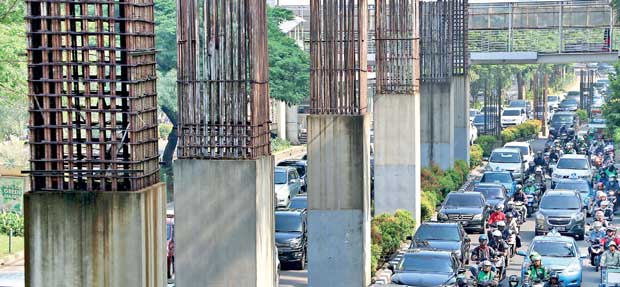15 Feb 2018 - {{hitsCtrl.values.hits}}

 The gap between global infrastructure needs and global infrastructure investment is widening. Inadequate investment in transport, communications and energy networks is estimated to be US $ 26 trillion in Asia alone.
The gap between global infrastructure needs and global infrastructure investment is widening. Inadequate investment in transport, communications and energy networks is estimated to be US $ 26 trillion in Asia alone.
The recent initiatives to improve connectivity by investing in infrastructure are welcome. But none of these initiatives is paying sufficient attention to the policy development and policy coordination efforts that will be needed to maintain financing in the long term.
The ongoing drive towards an ASEAN Economic Community (AEC) reflects an understanding that deep integration needs more than traditional trade policy. The Master Plan on ASEAN Connectivity (MPAC) outlines a web of mutually reinforcing connectivity dimensions: in addition to efficient physical infrastructure networks, the web includes policy coordination, people-to-people bonds as well as financial integration. Under the MPAC model, these all work separately and together to reduce impediments to international commerce. Implementation of this strategy has proved harder than expected, due to the ASEAN countries having inadequate skills and institutional capacity as well to shortages of financing.
The aims of the China-led Belt and Road Initiative (BRI) are quite similar to those of the AEC. Both emphasise mutual trust and respect and both rely on voluntary cooperation to achieve mutual benefits. The Chinese government has earmarked up to US $ 1 trillion for investments in infrastructure. Many early investments that build on and improve existing infrastructure are already underway.
This vigorous start is welcome, but the BRI needs to address several long-term challenges. China and other BRI members understand well the need to work on all of the five dimensions of— especially on policy coordination. In spite of this, early emphasis has been almost exclusively on physical connectivity: BRI states have paid insufficient attention to sustaining the pace of investments or to efficiently maintaining and operating new assets.
The announcement of the BRI in 2013, backed by the creation of the Asian Infrastructure Investment Bank (AIIB), has spurred others to pay more attention to investment in infrastructure. Multilateral development banks, including the World Bank and Asian Development Bank, have pledged to mobilise more resources. Japan launched its Partnership for Quality Infrastructure (PQI) in 2015 and more recently started pursuing a joint initiative with India to create an Asia Africa Growth Corridor (AAGC).
All of these initiatives to accelerate investment in infrastructure are timely since that the need is so great: even the US $ 1 trillion committed to the BRI is well short of what the region should be investing in infrastructure each year. But these investments will not be financially viable unless they are operated efficiently. In a similar vein to MPAC’s difficult implementation, infrastructure investments in the order of trillions of dollars need to be backed up by human capital investments in the order of billions of dollars. Who will pay for this?
Governments with support from multilateral development banks can afford to make the necessary secondary investments in human resource development and upgrading institutions. But this is not enough — governments also need to lead investment in economic infrastructure since much of the investment needed is in public goods. Neither governments nor development banks have the resources to finance the construction phase of economic infrastructure projects, so it will be essential that governments attract large-scale private sector investment.
Private-sector savings are available and institutional investors would like to invest their trillions to earn predictable long-term returns. But investors currently see the risks in infrastructure investment as too high, so only a tiny proportion of their savings are currently invested therein. Public–private partnerships to encourage private sector investment have proven disappointing: the risks to investors are not reduced and the additional costs resulting from this are either passed on to governments or lead to inflated financing costs and unaffordable user charges. Governments cannot expect cost-effective private investment in economic infrastructure until the existing projects are running efficiently and project risks are lowered.
A financing strategy that relies on professional experience, a sound understanding of project development cycles and successful precedents will be more likely to succeed. Teams of highly qualified professionals can be set up to take good ideas through each phase of the project development cycle. Motivated by well-designed incentives, these teams can work with public authorities during the low-cost but high-risk origination and structuring phases and then partner with other stakeholders to finance and execute the construction phases. These teams can then exit after projects are up and running with the option to re-finance projects using private capital (at an affordable cost) once the risks have been reduced.
Such a project catalysis strategy has been implemented successfully by Infraco (Asia). Infraco is an independent private-sector enterprise funded by the Private Infrastructure Development Group (PIDG) — a multi-donor organisation with members from seven countries and the World Bank Group. Infraco operations have leveraged US $ 1.2 billion of PIDG capital to attract US $ 21 billion of private and international financial institution capital into infrastructure projects. All governments could support initiatives along these lines to raise private sector investment on a scale that is large enough to narrow the currently widening gaps in economic infrastructure.
(Andrew Elek is Research Associate at the Crawford School of Public Policy, Australian National University)
01 Jan 2025 26 minute ago
01 Jan 2025 58 minute ago
01 Jan 2025 1 hours ago
01 Jan 2025 3 hours ago
01 Jan 2025 3 hours ago